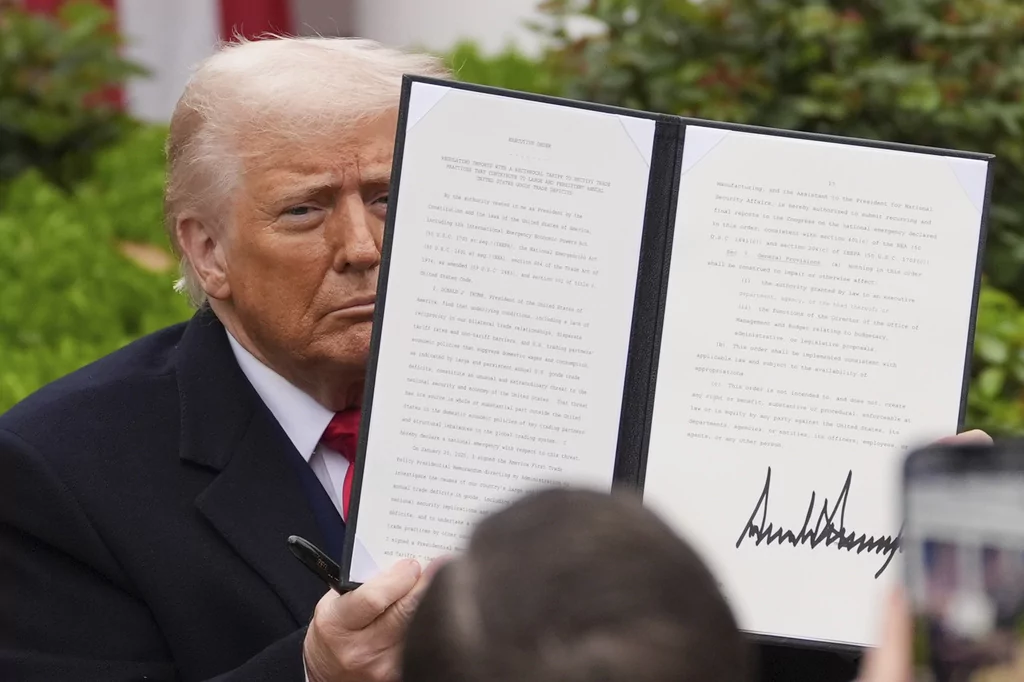
President Donald Trump announced his wide-ranging slate of reciprocal tariffs last week, causing varied responses from U.S. trade partners.
Trump unveiled the wide array of tariffs at a White House event, implementing a baseline 10% tariff and higher rates for other countries with similar duties on U.S. products. The president said the 10% rate went into effect on April 5 at 12:01 a.m., while the higher rates will go into effect on April 9 at 12:01 a.m.
Here is how some of the countries and the European Union have said they will respond to the looming tariffs.
European Union
The European Union was slapped with 20% tariffs by the Trump administration, and officials have vowed to retaliate with their own tariffs. EU leaders have also expressed a willingness to negotiate.
“The universal tariffs announced by the US are a major blow to businesses and consumers worldwide. Europe is prepared to respond. We’ll always protect our interests and values. We’re also ready to engage. And to go from confrontation to negotiation,” European Commission President Ursula von der Leyen said Wednesday evening.
By the next week, European officials had offered a proposal to drop all industrial tariffs if the United States agreed to do the same.
China
The White House announced that China would receive a 34% reciprocal tariff, which is in addition to the previous 20% tariff Trump levied on the country. China’s Ministry of Commerce responded to the latest tariffs a day a later by claiming Beijing would retaliate.
“China firmly opposes this move and will take resolute countermeasures to safeguard its legitimate rights and interests,” the country’s commerce ministry said in a statement, also calling the new tariffs “a typical case of unilateral bullying.”
On April 4, China announced it would impose retaliatory 34% tariffs on U.S. products imported into the country.
“This practice of the U.S. is not in line with international trade rules, undermines China’s legitimate rights and interests, and is a typical unilateral bullying practice,” the Chinese State Council Tariff Commission said in a statement.
United Kingdom
The United Kingdom did not receive any additional tariffs besides the baseline 10% tariff under Trump’s Wednesday announcement.
U.K. Business and Trade Secretary Jonathan Reynolds told the British House of Commons on Thursday that he believes a trade deal to remove the tariffs is “not just possible, it is favorable to both countries.”
Reynolds also released a document with potential items they may target with tariffs if a deal is not reached with the United States to remove the 10% blanket tariff by May 1.

Japan
Japan will have 24% tariffs slapped on its imports into the U.S. under Trump’s reciprocal tariffs plan.
Japanese Prime Minister Shigeru Ishiba said Thursday he was “disappointed” by the tariffs, but he did not preview any retaliatory response, according to Reuters. On April 7, the prime minister spoke with Trump over the phone and discussed the tariffs.
“On the economy, Prime Minister Ishiba stated that Japan has been the world’s largest investor in the U.S. for five consecutive years, expressed strong concerns that the tariff measures by the U.S. could weaken investment capacity among Japanese companies, and conveyed his view that the two countries should pursue ways to promote broader cooperation that benefits both Japan and the United States in a mutual manner,” the prime minister’s office said.
This cooperation, according to Ishiba’s office, would include the “enhancement” of investment,” and the prime minister “urged a reconsideration of the measures. The two leaders confirmed that they will continue to have candid and constructive discussions.”
U.S. Treasury Secretary Scott Bessent said in an X post that Trump tasked him and Jamieson Greer, U.S. trade representative, “to open negotiations to implement the President’s vision for the new Golden Age of Global Trade” with Japan.
“Japan remains among America’s closest allies, and I look forward to our upcoming productive engagement regarding tariffs, non-tariff trade barriers, currency issues, and government subsidies. I appreciate the Japanese government’s outreach and measured approach to this process,” Bessent added.
Germany
Germany, which is under the European Union, was hit with 20% tariffs as part of Trump’s sweeping plan.
The country’s economy minister said the premise of the tariffs was “nonsense,” according to the Associated Press, and called on the EU to band together during the tariff fight. He added that “America is in a position of weakness.”
South Korea
The Trump tariff plan puts 25% tariffs on South Korea.
South Korean Trade Minister Inkyo Cheong will visit Washington, D.C., this week to hold talks with Greer regarding the new tariffs, according to Bloomberg.
Trump and acting South Korean President Han Duck-soo spoke over the phone Tuesday about trade and a variety of other topics. The U.S. president declared it a “great call” and expressed confidence in a positive deal for both sides being worked out.
“I just had a great call with the acting President of South Korea. We talked about their tremendous and unsustainable Surplus, Tariffs, Shipbuilding, large scale purchase of U.S. LNG, their joint venture in an Alaska Pipeline, and payment for the big time Military Protection we provide to South Korea. They began these Military payments during my first term, Billions of Dollars, but Sleepy Joe Biden, for reasons unknown, terminated the deal. That was a shocker to all! In any event, we have the confines and probability of a great DEAL for both countries,” Trump said in a post on Truth Social.
“Their top TEAM is on a plane heading to the U.S., and things are looking good. We are likewise dealing with many other countries, all of whom want to make a deal with the United States. Like with South Korea, we are bringing up other subjects that are not covered by Trade and Tariffs, and getting them negotiated also. “ONE STOP SHOPPING” is a beautiful and efficient process!!! China also wants to make a deal, badly, but they don’t know how to get it started. We are waiting for their call. It will happen! GOD BLESS THE USA,” Trump added.
India
Trump announced he would put 27% tariffs on India.
Officials from the Asian country are exploring options to respond to the tariffs but reportedly appear to be looking at reaching a new trade deal with the U.S.
Malaysia
Malaysia will be hit with 24% tariffs under the sweeping tariff plan from the White House.
The country is looking to organize a regional response to the tariffs through the Association of Southeast Asian Nations. Malaysian Prime Minister Anwar Ibrahim posted on social media his hope to coordinate a response from ASEAN on Sunday.
“Malaysia, as ASEAN chair, will lead efforts to present a united regional front, maintain open and resilient supply chains, and ensure ASEAN’s collective voice is heard clearly and firmly on the international stage,” the prime minister said in the video.
Vietnam
The White House announced that Vietnam would receive one of the highest reciprocal tariff rates, at 46%, prompting officials in the country to order a task force to explore its options for responding.
Trump said on April 4 that he had a “very productive call” with Communist Party of Vietnam General Secretary To Lam and that he was looking “forward to a meeting in the near future.” He also said Vietnam would look to reduce tariffs to zero if it could make a deal with the U.S.
On April 7, the Vietnamese government said it would buy more U.S.-made products, including for defense and security, and asked for a 45-day delay on tariffs as they seek to negotiate the rate, according to Reuters.
Philippines
The president’s tariff plan is set to impose 17% tariffs on the Philippines.
Cristina Roque, the Philippines’ trade secretary, said on April 7 that she is seeking to meet with U.S. officials to discuss the tariffs but would consider reducing their own tariffs on the U.S., according to Bloomberg.
Indonesia
Under the tariff plan, Indonesia is slated to be slapped with 32% tariffs.
Indonesia’s Chief Economic Minister Airlangga Hartarto said Sunday that the country would not retaliate against the U.S. but instead seek a mutually beneficial solution to the current trade dispute. He also added that the country would explore increasing trade with Europe as an alternative to the U.S. and China.
Taiwan
As part of Trump’s tariff plan, the island nation will be hit with a 32% tariff, but the tariffs will not apply to semiconductor imports into the U.S.
WORLD LEADERS HOLD OFF ON RETALIATORY TARIFFS AS BESSENT URGES PATIENCE
Taiwanese President Lai Ching-te said he is looking “forward to working closely with the US to ensure a fair, mutually beneficial approach,” though he did not preview any reciprocal tariffs on Thursday.
“Taiwan values its strong economic partnership with the US. Our trade surplus with the US is a result of policy shifts, not unfair trade practices,” he said in a post on X, saying he wants an approach that “strengthens our shared prosperity.”



